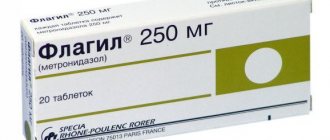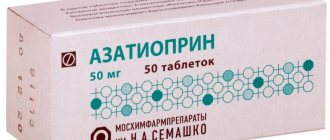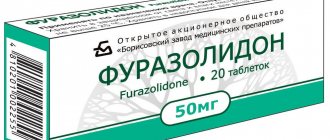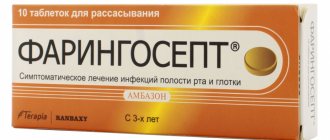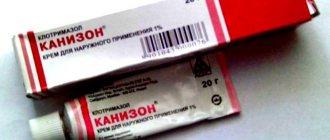Fluconazole is prescribed for the prevention and treatment of fungal infections. This is a synthetic drug that disrupts the life of pathogens. It is most often prescribed as part of drug therapy for candidiasis, but it can be used to treat other fungal diseases. Used in pediatric and therapeutic practice. Treatment is carried out under the supervision of a doctor.
Fluconazole was developed more than 20 years ago, but this drug is still included in the list of the safest and most effective medications according to the World Health Organization.
Release form and composition
Fluconazole is available in two forms:
- Capsules of 50, 100 and 150 mg.
Shape: oblong. Color: white with yellow cap, yellow with yellow cap, blue. The capsule contains white or yellowish powder. The drug has no specific odor and is tasteless.
Active ingredient: fluconazole 50, 100 or 150 mg. Excipients: lactose monohydrate, gelatinized starch, silicon dioxide, magnesium stearate. The capsule shell contains: titanium dioxide E-171, gelatin.
- Tablets of 50, 100 and 150 mg.
Shape: round, biconvex. Color: white, cream shade available. The tablets have no specific odor and are tasteless.
Active ingredient: fluconazole 50, 100 or 150 mg. Excipients: lactose monohydrate, gelatinized starch, sodium lauryl sulfate, silicon dioxide, magnesium stearate.
Solution for infusion Fluconazole (Fluconazole)
Instructions for medical use of the drug
Description of pharmacological action
An antifungal agent that has a highly specific effect, inhibiting the activity of fungal enzymes dependent on cytochrome P450. Blocks the conversion of lanosterol from fungal cells into the membrane lipid - ergosterol; increases the permeability of the cell membrane, disrupts its growth and replication. Fluconazole, being highly selective for fungal cytochrome P450, practically does not inhibit these enzymes in the human body (in comparison with itraconazole, clotrimazole, econazole and ketoconazole, it suppresses cytochrome P450-dependent oxidative processes in human liver microsomes to a lesser extent). Does not have antiadrogenic activity. Active against opportunistic mycoses, incl. caused by Candida spp. (including generalized forms of candidiasis due to immunosuppression), Cryptococcus neoformans and Coccidioides immitis (including intracranial infections), Microsporum spp. and Trichophyton spp.; for endemic mycoses caused by Blastomyces dermatidis, Histoplasma capsulatum (including immunosuppression).
Indications for use
— cryptococcosis, including cryptococcal meningitis and other localizations of this infection (including lungs, skin), both in patients with a normal immune response and in patients with various forms of immunosuppression (including in patients with AIDS, during transplantation organs); the drug can be used to prevent cryptococcal infection in patients with AIDS; - generalized candidiasis, including candidemia, disseminated candidiasis and other forms of invasive candidal infections (infections of the peritoneum, endocardium, eyes, respiratory and urinary tract). Treatment can be carried out in patients with malignant neoplasms, patients in the intensive care unit, patients undergoing cytostatic or immunosuppressive therapy, as well as in the presence of other factors predisposing to the development of candidiasis; — candidiasis of the mucous membranes, incl. oral cavity and pharynx (including atrophic candidiasis of the oral cavity associated with wearing dentures), esophagus, non-invasive bronchopulmonary candidiasis, candiduria, cutaneous candidiasis; prevention of relapse of oropharyngeal candidiasis in patients with AIDS; - genital candidiasis: vaginal candidiasis (acute and chronic recurrent), prophylactic use to reduce the frequency of relapses of vaginal candidiasis (3 or more episodes per year); candidal balanitis; - prevention of fungal infections in patients with malignant neoplasms who are predisposed to such infections as a result of chemotherapy with cytostatics or radiation therapy; — mycoses of the skin, including mycoses of the feet, body, and groin area; pityriasis versicolor (varicolored) lichen, onychomycosis; skin candidiasis; - deep endemic mycoses, including coccidioidomycosis, paracoccidioidomycosis, sporotrichosis and histoplasmosis in patients with normal immunity.
Release form
dose for infusion 2 mg/ml; polyethylene bottle (bottle) 100 ml, cardboard pack 1; doses for infusion 2 mg/ml; bottle (bottle) of curses 100 ml, cardboard pack 1; doses for infusion 2 mg/ml; bottle (bottle) of curses 100 ml with pendant, cardboard pack 1; doses for infusion 2 mg/ml; plyashka (bottle) bottle 100 ml, cardboard pack 1; doses for infusion 2 mg/ml; plyashka (bottle) 100 ml bottle with bottle, cardboard pack 1; doses for infusion 2 mg/ml; dark glass bottle (bottle) 100 ml, cardboard pack 1; dose for infusion 2 mg/ml; dark glass bottle (bottle) 100 ml with suspension, cardboard pack 1; doses for infusion 2 mg/ml; dark glass dance (butel) 100 ml, cardboard pack 1; doses for infusion 2 mg/ml; dark glass bottle (bottle) 100 ml with suspension, cardboard pack 1; Warehouse Capsules 1 capsule. fluconazole 50 mg, 150 mg additional ingredients: lactose monohydrate; pregelatinized starch; anhydrous silica; magnesium stearate; sodium lauryl sulfate capsule shell storage for 50 mg: titanium dioxide E-171; Barberry "Sunset" Zhovtiy E-110; gelatin warehouse capsule shell for 150 mg: titanium dioxide E-171; barnberry "Sunset" zhovtii T-110; Barberry "Ponso-4R" E-124; gelatin in blister 7 (50 mg) or 1 (150 mg) pcs.; There is 1 blister in a cardboard pack.
Pharmacodynamics
Antifungal agent, containing a highly specific action, inhibiting the activity of fungal enzymes stored in cytochrome P450. Blocks the conversion of lanosterol by fungal ergosterol; greater penetration of the cell membrane, disrupting its growth and replication. Fluconazole, being highly selective for the cytochrome P450 of fungi, practically does not inhibit enzymes in the human body (in comparison with itraconazole, clotrimazole, econazole and ketoconazole, it is less likely to inhibit deposits in id cytochrome P450 oxidative processes in microsomes of the human liver). Does not contain antiadrogenic activity. Active against opportunistic mycoses, incl. viklikanich Candida spp. (including generalized forms of candidiasis due to aphid immunosuppression), Cryptococcus neoformans and Coccidioides immitis (including internal cranial infections), Microsporum spp. i Trichophyton spp; for endemic mycoses, including Blastomyces dermatidis, Histoplasma capsulatum (including immunosuppression).
Use during pregnancy
In case of pregnancy, it is possible for heifers with life-threatening severe infections, when the effect of therapy outweighs the potential risk to the fetus (adequate and strictly controlled studies of the safety of stagnation in pregnant women have not been carried out). Information about a variety of congenital disorders in animals whose mothers were treated with high doses of fluconazole for 3 months and more - 400-800 mg / dose for coccidioidomycosis, although causally The relationship between these seizures and the use of fluconazole is unclear. Category of action for the fetus according to the FDA is C. At the hour of bathing, apply breastfeeding (concentrations of fluconazole in breast milk are equal to those in plasma).
Contraindications for use
Hypersensitivity, one-hour use of terfenadine with a large dose of fluconazole 400 mg or more; sedation with LD, which prolong the QT interval and are metabolized through CYP3A4 (such as cisapride, astemizole, quinidine) - div. "Mutuality."
Side effects
In patients who received a single dose for vaginal candidiasis. In a longitudinal clinical study in the United States, patients with vaginal candidiasis (n = 448) who received a single dose of fluconazole 150 mg, The total frequency of side effects possibly associated with the use of drugs has been calculated 26%; in patients who were taking the drug porivnyanna (n = 448) - 16%. The most common side effects associated with taking fluconazole were: headache (13%), fatigue (7%), abdominal pain (6%), diarrhea (3%), dyspepsia (1%), confusion (1% ), baked goods with relish (1%). Most side effects were of mild or moderate severity. Very rarely, marketing reports included angioedema and anaphylactic reactions. In patients who were treated with high doses of fluconazole for other infections In clinical trials, approximately 16% of 4,048 patients who were treated with fluconazole for 7 days or more, in Adverse reactions were indicated. Treatment was due to adverse effects in 1.5%, and in laboratory tests – in 1.3% of patients. During treatment with fluconazole, clinical manifestations of side effects were more often observed in HIV-infected patients (21%), compared with non-VIL-infected patients (13%). The number of patients who received treatment due to adverse effects was similar in both groups (1.5%). Adverse effects observed in clinical trials with fluconazole treatment for 7 or more days were reported in less than 1% of cases and were associated with treatment (n = 4048): tediousness (3.7%), headache (1.9 %), skin viscera (1.8%), vomiting (1.7%), abdominal pain (1.7%) and diarrhea (1.5%). Side effects associated with fluconazole treatment: hepatotoxicity, immunological reactions. Hepatotoxicity Combined clinical and marketing data indicate that fluconazole treatment is associated with rare episodes of serious hepatic toxicity, including death. There was no obvious relationship between fluconazole-associated hepatotoxicity and the daily dose, the effectiveness of therapy, the study, and the age of patients. The hepatotoxic effect of fluconazole is initially (but not always) reversed, symptoms that appear after administration of therapy. To avoid serious reactions in the liver, carefully monitor patients who show impaired functional liver tests during fluconase therapy. Treatment with fluconazole is likely to be prescribed in case of clinical manifestations of liver disease, which may be associated with treatment with fluconazole. Reactions in the side of the liver can vary in severity: from a slight transient increase in the level of liver transaminases to clinically significant hepatitis, cholestasis, fulminant liver failure, including a fatal result. Episodes of fatal hepatic reactions occurred most frequently in patients suffering from severe underlying illnesses (SNID, congestive illnesses) and often discontinued polymedicinal therapy. In two previous trials assessing the effectiveness of fluconazole in preventing relapses of cryptococcal meningitis, a statistically significant increase in the median of AST levels from baseline was detected. An increase in the level of serum transaminases less than 8 times the upper limit of the norm was detected in approximately 1% of patients who were treated with fluconazole. These episodes were observed in patients with severe underlying illnesses (SNID, a malignant new disease), most of whom had to undergo multiple concomitant medical therapy, including many diseases with known hepatotoxicity. The incidence of elevated transaminases was higher in patients who were taking one or more of the following medications simultaneously with fluconazole: rifampin, phenytoin, isoniazid, valproic acid, oral hypoglycemic Original properties - latent sulfonyl compounds. Immunological reactions: sporadic episodes of anaphylaxis have been reported. No side effects associated with fluconazole treatment have been established. On the side of the central nervous system: judge. Dermatological: exfoliative skin diseases, including Stevens-Johnson syndrome and toxic epidermal necrolysis; alopecia. Exfoliative skin diseases rarely developed when treated with fluconazole, and in patients with serious underlying diseases (SNID, congestive diseases) they rarely had a fatal result. If aphids treated with fluconazole show severe symptoms, the patient must be carefully monitored and if symptoms increase, treatment with fluconazole must be administered. Hematopoietic and lymphatic: leukopenia, including neutropenia and agranulocytosis, thrombocytopenia. Metabolic: hypercholesterolemia, hypertriglyceridemia, hypokalemia. Adverse effects observed in children During clinical trials of Phases 2 and 3 in the USA and Europe in 577 patients in 1 day - 17 deaths, who were treated with fluconazole in doses up to 15 mg/kg/add up to 1616 days, side effects children were prevented in 13% of cases; in patients who were taking the drug porivnyanna (n = 451) - in 9% of cases. The most significant side effects were the onset: vomiting (5.4%), abdominal pain (2.8%), fatigue (2.3%), diarrhea (2.1%). The treatment was administered through the emergence of unpleasant effects in 2.3% of patients, through improvement in laboratory tests (in most cases - elevated levels of transaminases and iron phosphatase) - in 1.4% of patients entiv.
Directions for use and doses
In the middle, intravenously, intravenously (with liquid no more than 20 mg/min.). Let's grow up, with cryptococcal infections, candidemia, diseminated candidiasis, etc. For invasive candidal infections, 400 mg is prescribed on day 1, then 200-400 mg 1 time per dose. The effectiveness of the treatment depends on the clinical and mycological reaction (for cryptococcal meningitis, set a minimum of 6-8 degrees). To prevent cryptococcal meningitis in patients on SNID therapy, a dose of 200 mg/dose can be continued for three hours. For oropharyngeal candidiasis - 50-100 mg 1 time per day for 7-10 days, for patients with immunosuppression - 14 days or more. To prevent relapses of oropharyngeal candidiasis in patients on SNID after completion of the full course of primary therapy - 150 mg 1 time per week. For atrophic oral candidiasis associated with wearing dentures, 50 mg 1 time per day for 14 days in combination with local antiseptic drugs to clean the denture. When in. Candidiasis of the mucous membranes (for genital candidiasis) - 50-100 mg / dose, treatment duration - 14-30 days. For vaginal candidiasis - 150 mg once, every day. To reduce the frequency of relapses, administer 150 mg once a month for 4-12 months, sometimes you may need to insulate more frequently. For balanitis caused by Candida - 150 mg/dose once. To prevent candidiasis, the recommended dose is 50-400 mg/dose, depending on the risk of developing a fungal infection. Due to the high risk of generalized infection, for example, in patients with acute, severe or persistent neutropenia, a dose of 400 mg/dose is recommended. Fluconazole is prescribed several days before the onset of neutropenia; after the increase in the number of neutrophils over 1 thousand. / µl of the liquid, continue to chew with a stretch of 7 dib. For skin infections, including mycoses of the feet, skin inguinal candidiasis - 150 mg 1 time per week or 50 mg 1 time per day, treatment duration - 2-4 days (up to 6 days for mycoses of the feet). For lichen - 300 mg 1 time per day for 2 days, for those who are ill, a third dose of 300 mg per day is required, in which case in some cases a one-time dose of 300-400 mg is sufficient; An alternative treatment regimen is stasis 50 mg 1 time per day for 2-4 days. For onychomycosis - 150 mg 1 time per week; The bath continues until the infected nail is changed. For the re-growth of nails on the fingers and toes, it normally takes 3-6 months and 6-12 months consistently. For severe endemic mycoses - 200-400 mg / dose for up to 2 days. The effectiveness of therapy depends on the individual; it can be 11-24 months for coccidioidomycosis, 2-17 months for paracoccidioidomycosis, 1-16 months for sporotrichosis and 3-17 months for histoplasmosis. In children, as well as in similar infections in adults, the use of a bath may have clinical and mycological effects. In children, the drug does not stagnate in a higher dose than it would in adults. Take the drug once a day (use special dosage forms for children). Children with candidiasis are prescribed 3 mg/kg/dose once for at least 3 days and for 2 days after symptom regression; for candidiasis of the mucous membranes - 3 mg / kg / dose in a single dose for at least 3 stretches; for the treatment of generalized candidiasis and cryptococcal infections (including meningitis) - 6-12 mg / kg / dose for 10-12 days (until laboratory confirmation of the presence of fluid in the liquor). For the prevention of fungal infections in children with decreased immunity, who are at risk of developing infections associated with neutropenia, which develops as a result of cytotoxic chemotherapy or exchange and therapy, - 3-12 mg / kg / dose depending on the severity and severity of induced neutropenia. For newborn children, the interval between administration of the drug is 72 years, for children aged 2-4 years, the same dose should be administered at an interval of 48 years. In children with impaired function, the additional dose of the drug should be changed (at the same proportional dosage as in adults) depending on the level of severity of the deficiency. In patients with summer age, if there is any dysfunction, it is important to follow the original dosage regimen for the drug. If you suffer from nitric deficiency (creatinine clearance less than 50 ml/min), the dosing regimen should be adjusted as indicated below. In case of congenital insufficiency, a “shock” dose of 50-400 mg is administered to the kidney; with creatinine clearance over 50 ml/min, the initial additional dose is prescribed, with creatinine clearance 11-50 ml/min — 50% of the recommended dose or the initial dose 1 time every 2 days; if you are sick and are on hemodialysis, 1 dose after skin dialysis.
Interactions with other drugs
Increases the effectiveness of coumarin anticoagulants (increased prothrombin hour; warfarin - on average by 12%), the concentration of zidovudine (increased side effects of zidovudine), cyclosporine, rifabutin (with one-hour stagnation and a description of the incidence of uveitis) and phenytoin at a clinically significant level (with one-hour stagnation, necessary control plasma concentration of phenytoin). Increases T1 / 2 theophylline and increases the risk of intoxication (dosage adjustment is necessary). When taking one-hour doses of similar sulfonyl compounds (chlorpropamide, glibenclamide, glipizide and tolbutamide), periodically monitor the concentration of glucose in the blood and, if necessary, make dosage adjustments hypoglycemic diseases (fluconazole increases T1 / 2). Hydrochlorothiazide increases the concentration of fluconazole in plasma by 40%, rifampicin changes T1 / 2 by 20% and AUC by 25%. Terfenadine and cisapride increase the risk of arrhythmias, including paroxysms of torsades de pointes.
Precautions for use
In patients with impaired function (with Cl creatinine less than 50 ml/xv), the dosing regimen should be adjusted; for a one-time dose, no dose change is required. Newborns in the first 2 years of life are prescribed at the same dose (mg/kg) as for children older than age, and at an interval of 72 years; for women 3-4 years old - the same dose at an interval of 48 years. During treatment, it is necessary to carefully monitor peripheral blood levels and liver function. If signs of hepatotoxicity, viscera, bullous changes, or erythema multiforme appear, discontinue therapy.
Special instructions for use
Treatment with fluconazole can be started before the results of culture and other laboratory tests are cleared, but after the results of these tests are cleared, follow-up therapy must be changed accordingly. The treatment must be continued until clinical/hematological remission occurs (the culprit is acute vaginal candidiasis). Early treatment should lead to relapses.
Storage conditions
Protected in a bright place, at a temperature below 30 ° C.
Best before date
36 months
ATX classification:
J Antimicrobials for systemic use
J02 Antifungal drugs for systemic use
J02A Antifungal drugs for systemic use
J02AC Triazole derivatives
J02AC01 Fluconazole
pharmachologic effect
The effect of the drug is due to its antifungal effect.
Pharmacodynamics
The drug is one of the highly specific antifungal agents. Fluconazole inhibits the activity of fungal enzymes. Active against various mycoses. These include Candida spp., Cryptococcus neoformans, Coccidioides immitis, Microsporum spp., Trichophyton spp.
Pharmacokinetics
Fluconazole is absorbed from the gastrointestinal tract. Eating does not affect this process. The maximum concentration of the drug in the body is reached after 1-1.5 hours. The bioavailability of the drug is 90%. The half-life of Fluconazole is 30 hours. The content of the drug in the blood plasma depends on the dosage used.
Fluconazole has the ability to penetrate into all biological fluids of the body. It is found in breast milk, saliva, joint fluid, sputum, and peritoneal fluid. 8 hours after taking the drug, its constant values in the vaginal secretion are achieved. Due to the penetration of Fluconazole into the cerebrospinal fluid, it is used to treat fungal meningitis.
The drug is excreted by the kidneys. Most of Fluconazole is excreted unchanged, the rest in the form of metabolites.
Instructions for use of Fluconazole
The method of use of the drug depends on the dosage form, manufacturer, dosage, patient’s condition and the characteristics of the identified disease. The course of drug therapy can be individual. Treatment is always prescribed by a doctor after clarifying the patient’s complaints and conducting laboratory tests.
Oral forms of the drug are taken orally, regardless of food intake. Capsules and tablets are washed down with water. To use the syrup, you need to use a measuring container, which can be found in the package. It is recommended to rinse the mouth with the liquid for two minutes before swallowing.
All instructions are described for reference purposes only. When taking an antimycotic, the patient should follow the instructions of the attending physician and the official instructions.
Application of capsules
- Treatment of cryptococcal infection in patients over fifteen years of age (with a body weight of at least 50 kilograms): the standard dosage regimen on the first day is eight capsules of fifty milligrams. On other days, the dosage can be maintained or reduced to four capsules of fifty milligrams once a day. The duration of therapy is determined by a specialist.
- Prevention of the disease in patients suffering from acquired immunodeficiency syndrome: four capsules (50 mg) per day for a long time.
- Candidal diseases: eight capsules of fifty milligrams on the first day and four capsules with a similar dose on the remaining days.
Application of syrup
- Treatment of cryptococcal infection in adults: 400 milligrams on the first day and 200 milligrams per day on the remaining days.
- Reducing the risk of developing the disease in patients with immunodeficiency: two hundred milligrams per day.
- Pathologies caused by Candida: 400 milligrams on the first day and 200 milligrams daily thereafter.
- Inflammation of the mouth and pharynx: fifty to one hundred milligrams per day for one or two weeks.
- Oral candidiasis with atrophy of the mucous membrane: fifty milligrams per day along with other medications.
- Damage to the vaginal mucosa: a single dose of one hundred and fifty milligrams.
The listed dosages in milligrams indicate the content of the active substance in the syrup, and not the volume of the liquid itself. Additional rules for use, including use in childhood, can be found in the official instructions.
Use of tablets
- Drug therapy in adults: from fifty to four hundred milligrams per day.
- Drug therapy in children: the dose is calculated taking into account 3-12 milligrams per kilogram of body weight per day. One time.
Application of the solution
The procedure is carried out using a dropper. The rate of intravenous administration should not exceed two hundred milligrams per hour. The daily dosage is determined by the doctor taking into account the patient's medical history. Transfusion therapy kits are used.
additional information
- If kidney function is impaired, the doctor must adjust the drug dosage regimen taking into account the creatinine clearance.
- There is a long list of drug interactions. Using fluconazole with other medicines may reduce the effectiveness of therapy, change the effects of other medicines, or cause complications. You need to tell your doctor about the medications you are taking and read the official instructions.
- Rarely, during treatment, patients develop serious (including life-threatening) pathologies of the liver tissue. If there is a history of diseases of this organ, the doctor should administer therapy with caution.
- Patients with acquired immunodeficiency often develop skin rashes after taking the drug. If such symptoms occur, you need to consult a specialist. Discontinuation of the drug may be necessary.
Official (complete) instructions can be found in the packaging.
Indications for use
Indications for the use of Fluconazole include:
- Diseases caused by candida. These include the following types of candidiasis: disseminated;
- generalized;
- invasive of any location.
The dosage of Fluconazole is determined by the attending physician depending on the disease and its severity.
Fluconazole for thrush
Thrush is a fungal infection of the female genital organs. Develops against the background of immunodeficiency. Symptoms of the disease include itching in the groin area, cheesy discharge and hyperemia of the mucous membranes. Thrush is caused by fungi of the genus Candida. Fluconazole is effective against this infection. Used as part of complex therapy. Before using the medicine, you should consult your doctor.
Fluconazole for nail fungus
Onychomycosis is a fungal infection of the nail plate. An integrated approach is used to treat this disease. The therapy includes the administration of Fluconazole. The dosage depends on the severity of symptoms. The drug blocks the spread of pathogenic microorganisms.
Fluconazole for cystitis
Cystitis is an inflammation of the mucous membrane of the bladder. The causative agents of the disease are bacteria, viruses or fungi. If there is a fungal infection, Fluconazole is added to therapy. It inhibits the action of pathogenic microorganisms, helping to reduce the severity of clinical symptoms.
Fluconazole for skin fungus
Mycosis of the skin is a fungal infection of the skin. Recently, there has been a spread of this disease. This is due to poor environmental conditions, frequent emotional overload and a decrease in the body's protective functions. An integrated approach is also used to treat mycosis of the skin. Fluconazole is prescribed orally to combat the causative agent of the disease.
Fluconazole for candidiasis
Diseases caused by fungal infections belong to the group of candidiasis. To treat pathology, antifungal agents are used, the effect of which extends to various infectious agents. Fluconazole is included in the complex therapy of candidiasis as etiotropic therapy.
Fluconazole for stomatitis
Fungal infection of the oral mucosa is a common disease in dental practice. This pathology requires complex treatment. The therapy includes Fluconazole. It safely and effectively inhibits the spread of fungal microorganisms.
Fluconazole for prevention
The use of Fluconazole is indicated not only for therapeutic purposes, but also for preventive purposes. To do this, the drug is taken in reduced dosages. The frequency of administration and duration of the course are determined by the attending physician depending on the disease and the risk of relapse.
Fluconazole for sore throat
Fungal tonsillitis is an infectious inflammatory disease that occurs as a result of exposure to yeast-like fungi and pathological cocci. A purulent coating appears on the mucous membrane of the throat, and the tonsils and lymph nodes become enlarged. Sore throat develops against the background of immunodeficiency. Fluconazole is prescribed to eliminate the causative agent of the disease and alleviate its symptoms.
special instructions
Therapy with the drug is continued until clinical and hematological remission occurs, since prematurely stopped treatment leads to relapses.
Fluconazole can be started in the absence of culture/other laboratory data, but if available, fungicidal therapy should be adjusted accordingly.
It is necessary to monitor blood counts, kidney and liver function during therapy. In case of liver/renal failure, the drug should be discontinued.
The hepatotoxic effect of fluconazole is usually reversible, and symptoms disappear after cessation of therapy.
Simultaneous use of the drug with coumarin anticoagulants requires monitoring of the prothrombin index.
Patients engaged in potentially hazardous work should be aware of the possibility of side effects such as convulsions and dizziness. It is recommended to be careful when driving vehicles and working with complex machines and mechanisms.
Interaction
The combined use of Warfarin and Fluconazole increases the duration of prothrombin time. Hypoglycemic agents increase the half-life of Fluconazole. In this regard, the chance of developing hypoglycemia increases. Combined use with Phenytoin increases its concentration in the blood. Hydrochlorothiazide increases the concentration of Fluconazole in the blood. The simultaneous use of Fluconazole and Zidovudine increases the side effects of the antiretroviral drug. When taken together with Cisapride, the negative effect on the cardiovascular system increases.
Contraindications
Absolute:
- simultaneous use of Fluconazole in doses ≥ 400 mg/day with drugs that prolong the QT interval (terfenadine, astemizole, etc.);
- lactation (breastfeeding period);
- children under 3 years of age (for tablets and capsules);
- lactose intolerance, lactase deficiency, glucose-galactose malabsorption (for tablets and capsules that contain milk sugar as one of the auxiliary components);
- hypersensitivity to the components of the drug and other antifungal substances, azole derivatives.
Relative (Fluconazole is used with caution due to the increased risk of complications): liver failure, rash that appears during therapy in patients with invasive/systemic and superficial fungal infections, potentially proarrhythmogenic conditions in patients with multiple risk factors (electrolyte imbalance, organic heart disease, simultaneous use with acetylsalicylic acid, drugs that cause arrhythmias, rifabutin and other cytochrome P450 inducers), pregnancy, use in doses <400 mg/day simultaneously with terfenadine, astemizole, etc.
The use of fluconazole during pregnancy should be avoided, except in cases of treatment of severe fungal infections that are potentially life-threatening to the woman, when the predicted benefit to her significantly outweighs the likely risk to the developing fetus.
Fluconazole analogs
In cases where it is not possible to use Fluconazole, it is allowed to use its analogues. These include Flucostat, Diflucan, Nystatin, Pimafucin, Mikosist, Itraconazole, Clotrimazole.
Which is better: Fluconazole or Flucostat?
Flucostat is an antifungal agent. The active substance of the drug is fluconazole. Available in the form of capsules and solution for intravenous administration. Flucostat is the first domestically produced drug based on fluconazole. German technologies are used to produce the drug. Effective against various mycoinfections. Indications for the use of Flucostat are generalized and disseminated candidiasis, fungal infections of the skin, mucous membranes of the oropharynx and esophagus, pityriasis versicolor, and onychomycosis.
Flucostat and Fluconazole have a similar active substance - fluconazole. The drugs are highly selective antimicrobial drugs. Fluconazole is produced in the form of tablets and capsules. Flucostat is available in the form of capsules and solution for intravenous administration. The drugs are produced by domestic manufacturers. However, German technologies are used to manufacture Flucostat.
Which is better: Fluconazole or Diflucan?
Diflucan is an antifungal medicine. Effective for the treatment of diseases caused by yeast, yeast-like and mold fungi. The active substance of the drug is fluconazole. Diflucan is available in the form of capsules, solution for intravenous administration and powder for suspension. Indications for use are candidiasis. Pathology may occur due to the following conditions:
- immunosuppressive therapy;
- long-term use of antibacterial therapy;
- immunodeficiency states;
- prevention of exacerbation of chronic forms of diseases.
Both drugs have an antimicrobial effect. The active substance of the drugs is fluconazole. Medicines are effective for similar conditions. The difference between Diflucan and Fluconazole is their release form. Diflucan is produced in the form of capsules, solution for intravenous administration and powder for suspension. Fluconazole is available in the form of capsules and tablets. Diflucan is produced by a European pharmaceutical company. Fluconazole is a product of a domestic manufacturer.
Which is better: Fluconazole or Nystatin?
Nystatin is an antibacterial agent of the polyene series. Has antifungal activity. The active substance of the drug is nystatin. The drug is available in the form of vaginal suppositories, ointments and tablets. Indications for the use of Nystatin are:
- vulvo-vaginal candidiasis;
- cutaneous candidiasis;
- fungal infection of the mucous membranes of the oropharynx and esophagus;
- prevention of the development of fungal complications during treatment with antibacterial drugs.
Fluconazole and Nystatin have an antifungal effect. The active substance of Fluconazole is fluconazole, and Nystatin is nystatin. Medicines differ in the form of release. Fluconazole is produced in the form of tablets and capsules. Nystatin is available in the form of vaginal suppositories, ointments and tablets. The choice of drug depends on the disease and its severity. Therefore, before purchasing the drug, it is recommended to consult your doctor.
Which is better: Fluconazole or Pimafucin?
Another representative of the antifungal group of drugs is Pimafucin. The active substance of the drug is natamycin. The drug is available in several forms. These include tablets, cream and vaginal suppositories. This explains the widespread use of the drug for various diseases caused by fungal infections. Among them:
- intestinal candidiasis that occurs while taking certain medications;
- cutaneous candidiasis;
- nail candidiasis;
- mycosis of the external auditory canal.
The drugs have a similar mechanism of action. I use them to treat fungal infections. The differences between Fluconazole and Pimafucin lie in the active ingredients and release form. Fluconazole is produced in the form of tablets and capsules. The active substance of the drug is fluconazole. Pimafucin is available in the form of cream, tablets and vaginal suppositories. The active ingredient of Pimafucin is natamycin.
Which is better: Fluconazole or Mikosist?
Mikosist is an antifungal drug. Belongs to the group of triazole drugs. Active against various fungal infections. The active ingredient of the drug is fluconazole. The drug is available in the form of capsules and solution for infusion. Mikosist is used in the presence of the following diseases:
- genital candidiasis;
- fungal infections of the skin and nails;
- generalized candidiasis;
- fungal infection of the mucous membranes;
- cryptococcosis;
- prevention of exacerbation of chronic diseases.
Fluconazole and Mikosist have similar effects. The drugs are effective against various fungal infections. The active substance of both drugs is fluconazole. The differences between Fluconazole and Mikosist lie in the form of release of the drugs and their manufacturer.
Which is better: Fluconazole or Itraconazole?
Itraconazole is a broad-spectrum antifungal agent. Belongs to the group of triazole derivatives. Prescribed for identifying dermatophytes, yeast-like and mold fungi. The active substance of the drug is itraconazole. Indicated for various infectious diseases caused by fungal microorganisms. Available in capsule form.
The differences between Itraconazole and Fluconazole are the drug release form, active substances and manufacturer. You should not choose the drug and determine its dosage on your own. To do this, it is recommended to consult a doctor.
Which is better: Fluconazole or Clotrimazole?
Clotrimazole is a broad-spectrum antifungal drug. The drug belongs to the group of imidazole derivatives. Clotrimazole has antibacterial, antiprotozoal, trichomonacid and antifungal effects. The active substance of the drug is 1-[(2-chlorophenyl)diphenylmethyl]-1H-imidazole). Produced in the form of powder for topical use, cream, ointment, vaginal tablets, suppositories or gel, spray and solution for external use, paste for application to the skin.
Indications for use include:
- dermatomycosis;
- athlete's foot;
- candidiasis;
- microsporia;
- dermatophytosis;
- vulvovaginitis;
- candidiasis vulvitis;
- sanitation of the birth canal before childbirth.
Fluconazole and Clotrimazole have an antifungal effect. Active against many fungal microorganisms. The active ingredient of Fluconazole is fluconazole, while that of Clotrimazole is 1-[(2-chlorophenyl)diphenylmethyl]-1H-imidazole). Other differences between the drugs are their form of release and manufacturers. Fluconazole is produced by a domestic manufacturer in the form of tablets and capsules. Clotrimazole is produced by a European pharmaceutical company in the form of a powder for topical use, cream, ointment, vaginal tablets, suppositories or gel, spray and solution for external use, paste for application to the skin. It is recommended to consult a doctor before using medications. The specialist will choose a medicine based on the examination.
Adverse reactions
It is impossible to completely eliminate side effects during drug therapy. Some patients experience undesirable reactions caused by the effect of the active substance on organs and tissues. A typical side effect is the sensitivity of the immune system to the chemical compounds contained in the drug. To reduce the risk of allergies, you must first study the composition of the product and clarify your medical history.
Other unwanted effects:
- Nervous system: cephalalgia, dizziness, fatigue, convulsive reactions.
- Digestive system: lack of appetite, disruption of the liver tissue, vomiting, discomfort in the abdomen, bloating, increased gas formation in the intestines, loose stools, inflammation and necrosis of the liver.
- Immune system: skin rashes, redness of the integumentary tissues, Stevens-Johnson syndrome, other erythemal reactions, Lyell's syndrome, Quincke's edema, urticaria and other anaphylactoid manifestations.
- Hematopoietic system: decreased levels of neutrophils, granulocytes, platelets and leukocytes. Hemorrhages are possible.
- Cardiovascular system: prolongation of the QT interval, impaired contraction of the ventricles of the heart.
- Additionally: kidney dysfunction, baldness, potassium deficiency, increased cholesterol and triglycerides.
The list of adverse reactions also depends on the dosage form. Severe complications during therapy, including liver pathologies, are rare, but the doctor must take into account all possible risks before prescribing the medicine.
Use during pregnancy and breastfeeding
- Adequate and controlled studies of the safety of fluconazole in pregnant women have not been conducted. The use of fluconazole during pregnancy should be avoided, except in cases of severe and potentially life-threatening fungal infections when the expected benefit of treatment outweighs the possible risk to the fetus.
- Women of childbearing age should use reliable contraception during treatment.
- Fluconazole is detected in breast milk in concentrations close to plasma concentrations, so use during lactation (breastfeeding) is not recommended.

